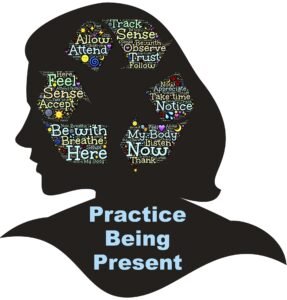
Meditation Techniques for Mental Health: A Path to Inner Serenity

In today’s fast-paced world, where stress and anxiety often seem like constant companions, it’s more important than ever to prioritize our mental health. One effective and time-tested method for achieving a sense of inner calm and emotional well-being is meditation.
This ancient Yoga practice has gained popularity in the past few years for its proven benefits in reducing stress, improving focus, and enhancing overall mental health to heal your soul. In this article, we’ll explore various meditation techniques that can help you achieve a sense of serenity and balance in your life.
1. Mindfulness Meditation- Being Present

This is the most powerful Meditation Technique for Mental Health, Mindfulness meditation is a technique that involves paying close attention to the present moment. It’s about observing your thoughts, emotions, and sensations without judgment while sitting with your eyes closed. By doing so, you can become more aware of your thought patterns and develop a better understanding of yourself.
To practice MM, get started with mindfulness meditation, and find a quiet place to sit or lie down. Close your eyes, take a few deep breaths, and begin to focus on your breath. Pay attention to the rise and fall of your chest or the sensation of your breath as it passes through your nostrils. Whenever your mind begins to wander, gently redirect your focus back to your breath. With practice, you’ll become more skilled at staying present and calming your mind.
2. Loving-Kindness Meditation- Cultivating Compassion

Loving-kindness meditation, also known as “Metta” meditation, is all about generating feelings of love and compassion. This practice can help improve your self-esteem and enhance your relationships with others.
To practice LKM, Start by sitting in a comfortable position and closing your eyes. Begin by directing loving-kindness toward yourself, silently reciting phrases like, “May I be happy. May I be healthy, May I be safe, May I live with ease.” Then, expand your focus to include loved ones, acquaintances, and even people you may have conflicts with. The idea is to send out well-wishes to all beings, cultivating a sense of love and compassion for everyone.
3. Guided Meditation- A Helping Hand

Guided meditation is an excellent choice for beginners or those who prefer a structured practice. In guided meditation, you listen to an instructor’s soothing voice as they lead you through the process. This technique can help you stay focused and guide your thoughts.
To practice GM, You can find countless guided meditation sessions online or through meditation apps. These guided sessions cover various themes, from relaxation and stress relief to personal growth and inner healing. Simply choose a session that resonates with you, find a quiet space, and let the guide lead you on a journey to relaxation and self-discovery.
4. Body Scan Meditation- Physical and Mental Awareness

The body scan meditation technique is all about bringing awareness to your physical sensations. By scanning your body from head to toe, you can identify areas of tension and stress, allowing you to release and relax. This is similar to the Yoga Nidra technique.
To practice body scan meditation, lie down in a comfortable position and close your eyes. Start at the top of your head and mentally move your focus down through each part of your body, paying close attention to any areas of tension or discomfort. As you breathe and bring your awareness to these areas, visualize the tension melting away. This practice can help reduce physical discomfort and ease stress and anxiety.
5. Transcendental Meditation- A Deeper Dive

Transcendental Meditation (TM) is a specific meditation technique that involves silently repeating a mantra to achieve a state of restful awareness. TM has been associated with numerous mental health benefits, including stress reduction, improved concentration, and enhanced overall well-being.
To practice TM, you’ll need to learn the technique from a certified instructor. They will provide you with a mantra that is specific to you. During your meditation sessions, you’ll silently repeat this mantra, allowing your mind to settle into a state of deep rest. With regular practice, you can experience profound mental and emotional transformations.
6. Breath Awareness Meditation- Finding Your Center

Breath awareness meditation is a simple yet powerful technique that focuses on the breath. By paying attention to your breath, you can anchor yourself in the present moment, calm your mind, and reduce stress.
To Practice BAM, Sit in a comfortable position and close your eyes. Take deep, slow breaths, and simply observe the breath as it moves in and out of your body. Notice the rise and fall of your chest or the coolness of the air as it enters your nostrils. When your mind starts to wander, gently bring your attention back to your breath. This practice is an excellent way to center yourself and regain your mental equilibrium during times of stress.
7. Zen Meditation: Embracing Simplicity

Zen meditation, also known as Zazen, is a traditional Japanese practice that emphasizes simplicity and mindfulness. It involves sitting in a specific posture, typically on a cushion, and focusing on your breath and the present moment.
To practice Zen meditation, find a quiet space and sit cross-legged or on a chair with your back straight. Rest your hands on your lap, with your right hand on top of your left, and your thumbs lightly touching. Focus on your breath, counting your inhalations and exhalations. Whenever your mind drifts, acknowledge the distraction and gently return to your breath. This technique encourages a profound sense of inner peace and clarity.
8. Chakra Meditation: Balancing Energy Centers

Chakra meditation is an ancient Indian practice that focuses on balancing the body’s energy centers, or chakras. There are seven main chakras in the body, each associated with specific qualities and emotions.
To begin chakra meditation, sit in a comfortable position and close your eyes. Visualize each chakra starting from the base of your spine (root chakra) and moving up to the crown of your head (crown chakra). As you focus on each chakra, imagine it spinning and radiating a particular color and quality. This practice can help align and balance your energy, promoting emotional and mental stability.
9. Yoga Nidra: The Yoga of Sleep

This one is my favorite practice, Yoga Nidra, often referred to as “yogic sleep,” is a guided meditation that induces a deep state of relaxation. It can be especially helpful for those dealing with insomnia, stress, or anxiety.
To practice Yoga Nidra, lie down in a comfortable position, close your eyes, and follow the guidance of an instructor. The session typically involves a body scan, breath awareness, and visualization, promoting profound relaxation and rejuvenation. Yoga Nidra allows you to access the restorative benefits of sleep while maintaining conscious awareness.
10. Walking Meditation: Finding Peace in Motion

If sitting still for extended periods isn’t your preference, walking meditation offers a more active approach to mindfulness. This technique combines the benefits of meditation with gentle, purposeful walking.
To practice walking meditation, find a quiet and safe path to walk in a straight line. Begin to walk slowly and intentionally, paying close attention to the sensations of each step. You can synchronize your breath with your steps, such as taking a deep inhale for every two or three steps and exhaling for the same number of steps. Walking meditation promotes mindfulness and can be a refreshing way to clear your mind and reduce stress.
11. Sound Healing Meditation: Harmonizing with Vibrations

Sound healing meditation incorporates the use of soothing sounds or music to induce a meditative state and alleviate stress and anxiety. This practice can involve singing bowls, gongs, nature sounds, or calming music.
To practice sound healing meditation, find a quiet space and play your chosen sound or music. Close your eyes and let the vibrations and harmonies wash over you. Focus on the sensation and emotions that arise, allowing the sounds to guide you into a meditative state. Sound healing meditation is an excellent way to release tension and promote mental and emotional balance.
Conclusion: A Journey to Mental Wellness

Meditation is a versatile and effective tool for improving mental health. By incorporating these various meditation techniques into your daily routine, you can experience reduced stress, increased emotional balance, and enhanced overall well-being. Whether you choose mindfulness, loving-kindness, guided meditation, body scan, Transcendental Meditation, or breath awareness or any technique you feel connected each technique offers a unique path to inner serenity.
As you embark on your meditation journey, remember that consistency is key. Regular practice is essential for reaping the full benefits of meditation. Find a technique that resonates with you, set aside time each day to meditate, and watch as your mental health and overall quality of life improve.Experiment with different techniques to discover which ones resonate with you and enhance your journey to mental wellness.
What is Fitness(a holistic Approach to Physical and Mental Well-being)
Always seek professional guidance for safe practice.
Startough-Stay Tough!

One thought on “Meditation Techniques for Mental Health: A Path to Inner Serenity”